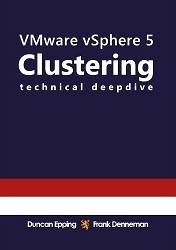 The VMware vSphere 5 Clustering Technical Deepdive book has been published a while ago and probably most of you already read it. I purchased the book right after the release and I was reading the book really slowly due to some time management issues. Today, I have finally finished reading this awesome book that was written by Duncan Epping (@DuncanYB) and Frank Denneman (@FrankDenneman) and now it’s time for a little review.
The VMware vSphere 5 Clustering Technical Deepdive book has been published a while ago and probably most of you already read it. I purchased the book right after the release and I was reading the book really slowly due to some time management issues. Today, I have finally finished reading this awesome book that was written by Duncan Epping (@DuncanYB) and Frank Denneman (@FrankDenneman) and now it’s time for a little review.
This book consists of more than 340 pages about the most important key features of VMware vSphere 5: the VMware High Availability (HA), VMware Distributed Resource Scheduler (DRS) including Distributed Power Management (DPM) and new in this book is the vSphere Storage DRS (SDRS) which was released in vSphere 5.
The first part of the book concentrates on the vSphere HA and includes topics about the redesigned HA stack, new components like the Fault Domain Manager (FDM) and the new Master/Slave node concept. The new “Datastore Heartbeating” feature and the state where a cluster can be isolated or partitioned are also explained in this chapter.
The second part of the book gives you detailed information about the vSphere DRS. It includes topics about some new features of DRS in vSphere 5 as well as vMotion and EVC. The DRS and DPM calculations and recommendations are extensively explained with good examples and of course the resource pools and it’s control.
Part three of the book is about the new vSphere Storage DRS feature in vSphere 5. In my opinion, this is one of the coolest features of vSphere 5. The chapters in this part of the book will discuss all key features of SDRS like resource aggregation, load balancing, datastore maintenance mode but also how it is calculated and when it is invoked. The Storage vMotion (including the new Mirror Mode), Storage I/O Control and some new enhancement in vSphere 5 are also described in this part.
Part four, called “Integration” is an interesting chapter. It describes the integration points of HA, DRS and SDRS. For example, the sub-topic HA and Stateless ESXi describe what happens with the HA configuration when a host reboots. The topics are small, to the point and give you good understanding about the integration points in vSphere 5.
This is just a small summary of the main topics of the VMware vSphere 5 Clustering Technical Deepdive book, there is a lot more. Just like in the previous version of the book, the basic design principle quotes are also included but not indexed which was the case in the previous book. The technical level is high but the topics are interesting for all VMware enthusiasts. The figures and tables are clear and make some topics easier to understand.
Summary
Although the old HA and DRS Technical Deepdive book is great, the new vSphere 5 Clustering book is even better. I know from twitter that Duncan and Frank worked really hard on this book and managed to complete it just in time the vSphere 5 was released. I guess they really have raised the bar for themselves this time. Just like I said earlier, this book is great and this is the bible you must have read if you are a VMware System Administrator, Engineer, Consultant or Architect.
You can order your copy here or here.
Cheers!
– Marek.Z
Be the first to comment